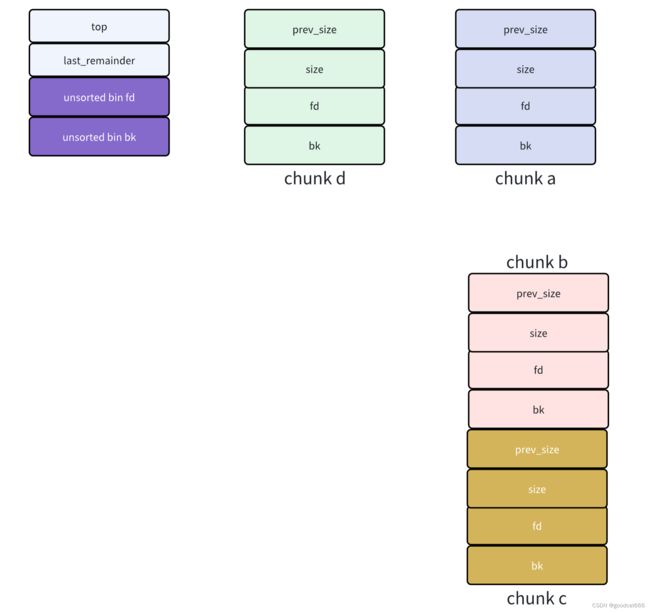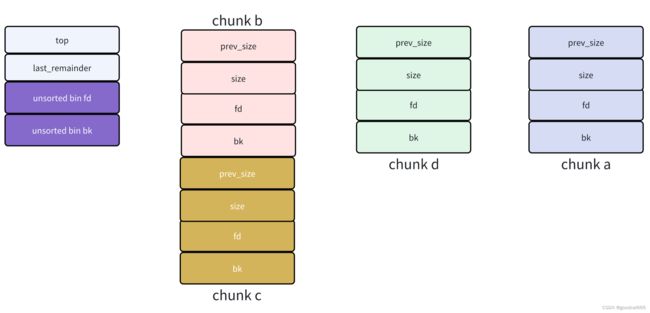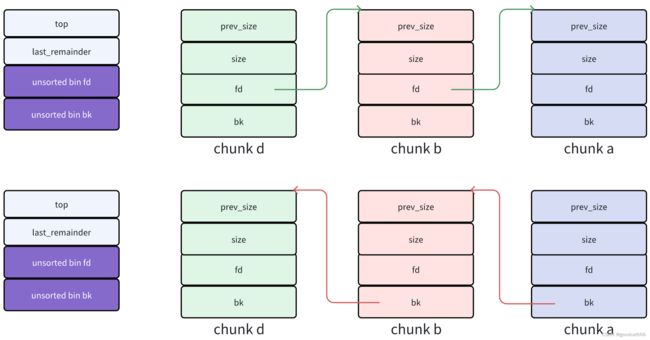how2heap-2.23-07-unsafe_unlink
unlink的作用
在glibc-2.23的malloc.c中搜索unlink,找到unlink的使用场景
-
_int_malloc- 从恰好大小合适的largebin中获取chunk,发生unlink
- 从比malloc要求大的largebin中取chunk,发生unlink
-
_int_free- free之后,与前后空闲的chunk进行合并
-
malloc_consolidate- consolidate时,chunk之间的unlink
-
_int_realloc- 向前扩展,合并物理相邻高地址空闲chunk
https://blog.csdn.net/qq_41453285/article/details/98850842
粗略理解正常unlink的整体过程
#include unlink发生前unsorted bin中的布局
就是free( c)执行之前,unsorted bin中的布局(连接线就不画了,入unsorted bin链可以看 how2heap-2.23-05-unsorted_bin_attack)

释放free(c)准备unlink
chunk b unlink
再将合并后的chunk b和chunk c插入到unsorted bin链中
只关心unlink,及其细节
在unlink发生前,chunk b与周围chunk在unsorted bin中的连线关系
chunk b unlink
在本示例中:就是chunk b脱链,chunk d和chunk a重新连接

再把图中已经被unlink的chunk b去除一下
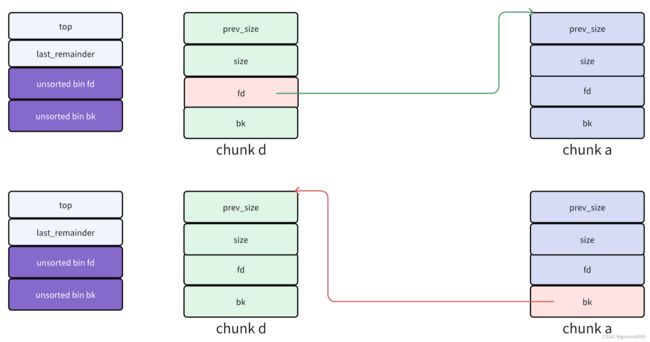
符合unlink的核心步骤,下面是较旧版本中unlink实现代码
#define unlink(P, BK, FD)
{
BK = P->bk;
FD = p=>fd;
FD->bk = BK;
BK->fd = FD:
}
较旧版本中unlink的安全性问题
如果有漏洞,可以篡改chunk b的fd,bk
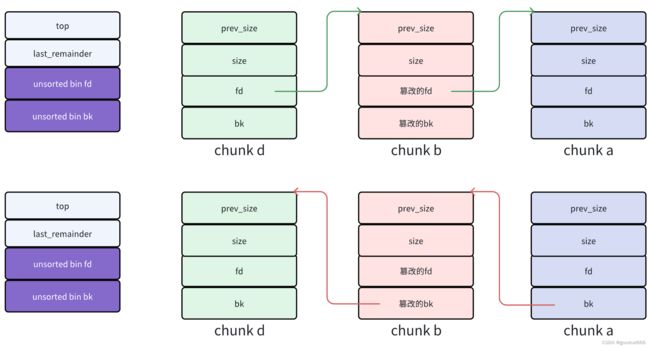
还未unlink的时候,chunk b fd和bk就已经指向了被篡改后的位置
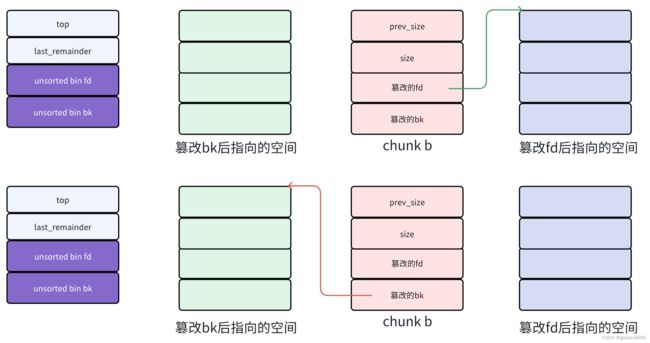
在unlink的时候,就能修改篡改后fd,bk指向空间的数据
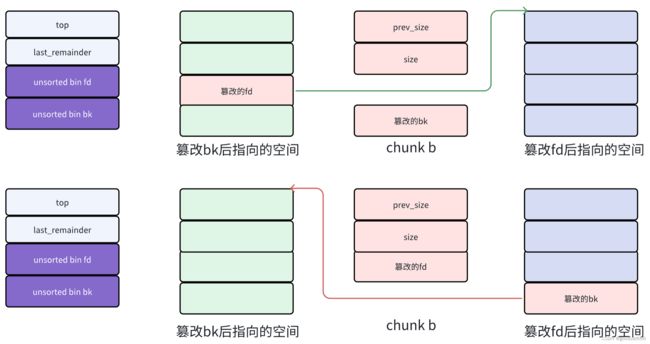
如果篡改fd指向__free_hook相关空间,篡改bk为system的地址,就很容易get shell
回到how2heap中的unsafe_unlink
之后的版本,unlink的原理没变,但是增加了检查
// 由于 P 已经在双向链表中,所以有两个地方记录其大小,所以检查一下其大小是否一致(size检查)
if (__builtin_expect (chunksize(P) != prev_size (next_chunk(P)), 0)) \
malloc_printerr ("corrupted size vs. prev_size"); \
// 检查 fd 和 bk 指针(双向链表完整性检查)
if (__builtin_expect (FD->bk != P || BK->fd != P, 0)) \
malloc_printerr (check_action, "corrupted double-linked list", P, AV); \
// largebin 中 next_size 双向链表完整性检查
if (__builtin_expect (P->fd_nextsize->bk_nextsize != P, 0) \
|| __builtin_expect (P->bk_nextsize->fd_nextsize != P, 0)) \
malloc_printerr (check_action, \
"corrupted double-linked list (not small)", \
P, AV);
来看看how2heap中unsafe_unlink,大佬们是怎么绕过的
#include 首先绕过(P->fd->bk != P || P->bk->fd != P) == False
首先执行chunk0_ptr = (uint64_t*) malloc(malloc_size);

再执行,就绕过了(P->fd->bk != P || P->bk->fd != P) == False
chunk0_ptr[2] = (uint64_t) &chunk0_ptr-(sizeof(uint64_t)*3);
chunk0_ptr[3] = (uint64_t) &chunk0_ptr-(sizeof(uint64_t)*2);
这里,在chunk0的内容头部中伪造了一个chunk

如何理解

绕过chunksize(P) != prev_size (next_chunk(P))
chunk0和chunk1是连续申请的,其虚拟内存相连
chunk0_ptr = (uint64_t*) malloc(malloc_size); //chunk0
uint64_t *chunk1_ptr = (uint64_t*) malloc(malloc_size); //chunk1
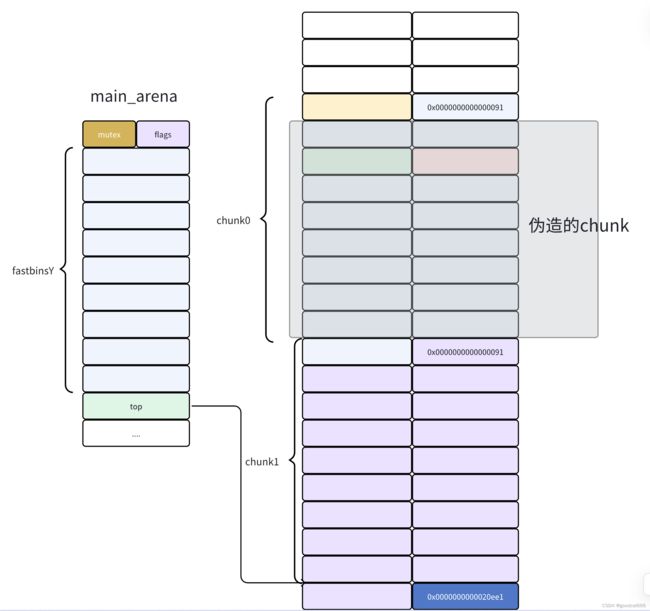
修改chunk1的prev_size和prev_in_use位,使堆管理器认为伪造的chunk和chunk1是相连的,且伪造的chunk已经处于释放状态
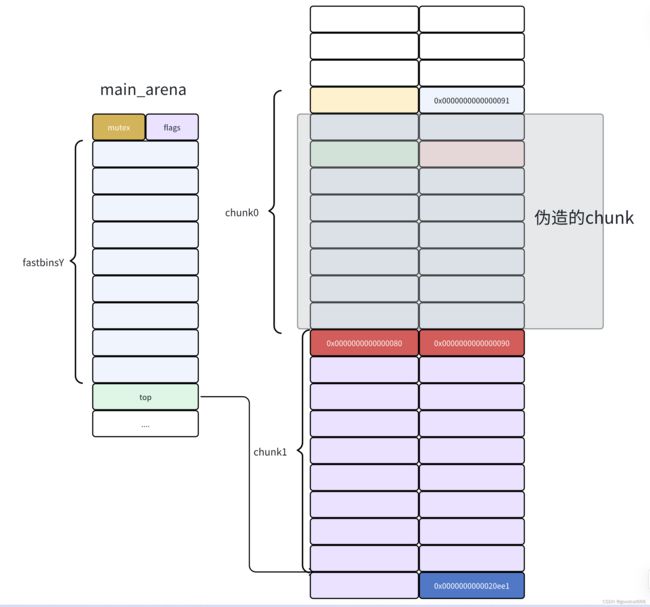
现在释放chunk1,就能触发伪造的chunk进行unlink操作
unlink操作引发漏洞
从这两个图,可以看到chunk0_ptr存储的内容会被覆盖


到底覆盖为&chunk0_ptr-0x10还是&chunk0_ptr-0x18,可以从unlink的代码中看出
#define unlink(P, BK, FD)
{
BK = P->bk;
FD = p=>fd;
FD->bk = BK;
BK->fd = FD:
}
chunk0_ptr的内容被覆盖为&chunk0_ptr-0x18,也就是chunk0_ptr认为自己指向的chunk从&chunk0_ptr-0x18开始
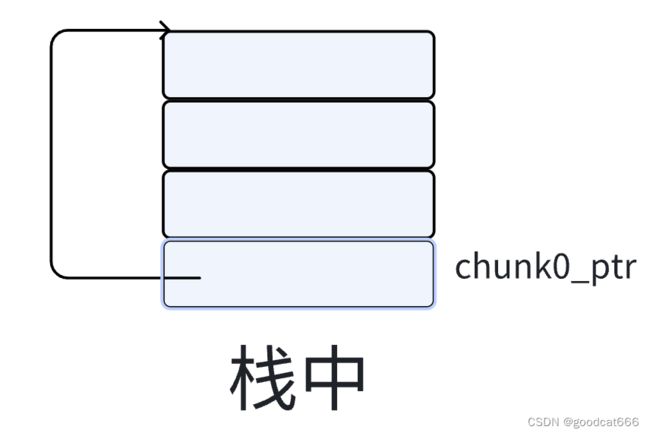
漏洞的利用
从上图可以看出,chunk0_ptr可以通过自己指向chunk内容的下标3(从下标0开始),就能更改chunk0_ptr指向的chunk,实现指向任意地址
char victim_string[8];
strcpy(victim_string,"Hello!~");
chunk0_ptr[3] = (uint64_t) victim_string;
然后就能可以进行任意地址写了
chunk0_ptr[0] = 0x4141414142424242LL;

